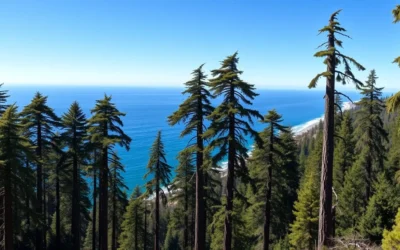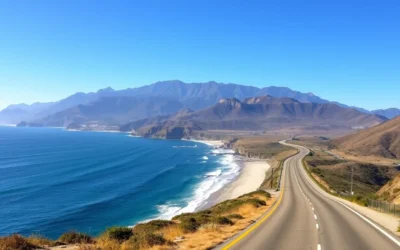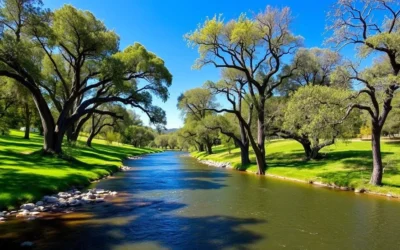Did you know that the Farallon Islands, just 43 km (27 miles) west of San Francisco, host the largest seabird breeding colony in the contiguous United States? This remote archipelago is home to over 300,000 breeding seabirds and serves as a critical feeding ground for great white sharks, whales, and countless marine species. Despite being visible from San Francisco on clear days, these mysterious islands remain one of California’s best-kept natural secrets, offering wildlife encounters that rival destinations like the Galapagos.
Getting There & Planning Your Journey
The Farallon Islands are accessible only by boat, as the islands themselves are closed to the public to protect the delicate wildlife habitats. The nearest major airport is San Francisco International Airport (SFO), which offers connections to destinations worldwide. Oakland International Airport (OAK) is another convenient option.
From San Francisco, several tour operators offer day trips to the islands. The boat journey takes approximately 1.5-2 hours each way, depending on weather conditions. Most tours depart from marinas in San Francisco, such as Fisherman’s Wharf or the Marina District.
Plan Your Farallon Islands Adventure
Start by booking your flights to San Francisco, the gateway to the Farallon Islands.
Since you’ll need to stay in San Francisco before and after your Farallon Islands excursion, booking accommodations near the marina districts will make your early morning departure more convenient. Most tours require check-in between 7:30-8:00 AM.
Find the perfect place to stay in San Francisco before your Farallon Islands adventure.
Best Time to Visit & Weather Tips

The Farallon Islands offer different wildlife experiences throughout the year, so the best time to visit depends on what you hope to see.
Recommended Seasons
- Late Spring (April-May): Peak seabird nesting season with thousands of birds covering the islands.
- Summer (June-August): Best for whale watching, especially humpback and blue whales. Weather conditions are typically most favorable.
- Fall (September-November): Prime time for observing great white sharks and the continuation of whale season.
Seasons to Avoid
- Winter (December-February): Rough seas make trips uncomfortable and many are canceled due to weather. However, this is elephant seal breeding season.
- Stormy periods: Tours don’t operate during high winds or heavy fog for safety reasons.
Weather Tip: The Farallon Islands experience foggy conditions frequently, especially in summer mornings. The fog often burns off by midday. Ocean conditions can change rapidly, so dress in layers and prepare for wind, spray, and cool temperatures even on sunny days.
Average temperatures around the islands range from 10-15°C (50-59°F) year-round, with water temperatures between 10-13°C (50-55°F). The islands receive most rainfall between November and April.
Getting Around Locally

Since visitors aren’t permitted to land on the Farallon Islands, all exploration happens from boats that circle the islands. Tour vessels typically make a complete circumnavigation of Southeast Farallon Island, the largest in the group, providing views of all the significant landmarks and wildlife hotspots.
Most tour boats are equipped with comfortable viewing areas both inside and on deck. Naturalist guides use the boat’s PA system to point out wildlife and explain the islands’ ecology and history as you cruise around.
Book Your Farallon Islands Tour
Secure your spot on a guided tour to experience the incredible wildlife of the Farallon Islands.
Where to Stay
Since overnight stays on the Farallon Islands are not permitted for visitors, you’ll need to base yourself in San Francisco. Here are the best neighborhoods to stay in for easy access to Farallon Islands boat tours:
Fisherman’s Wharf
The most convenient location, as many Farallon tours depart from piers in this area. You’ll find numerous hotels ranging from budget to luxury, plus easy access to San Francisco attractions.
Marina District
Close to departure points and offers a more residential feel with boutique hotels and vacation rentals. Enjoy beautiful views of the Golden Gate Bridge and easy access to the Presidio.
North Beach
San Francisco’s Little Italy is within walking distance of tour departure points while offering charming streets, excellent restaurants, and a more authentic neighborhood experience.
Find Your Perfect San Francisco Stay
Book accommodations near tour departure points for convenience.
Dining & Local Cuisine

While there are no dining options on the Farallon Islands themselves, your tour experience will include food considerations:
On-Board Dining
Most tour operators offer light refreshments during the journey. Some provide a basic lunch or snacks, while others recommend bringing your own food. Check with your specific tour company about their food and beverage policies.
Packing Food Tips
- Bring easily digestible foods like crackers, bread, and ginger snacks to help prevent seasickness
- Pack water-rich fruits and vegetables to stay hydrated
- Avoid greasy, spicy, or heavy foods that might worsen seasickness
- Bring more water than you think you’ll need – the ocean air is dehydrating
Pre/Post Tour Dining
Before your early morning departure or after returning from your tour, San Francisco offers excellent dining options near the marina areas:
Fisherman’s Wharf Area
- Fresh seafood restaurants specializing in Dungeness crab
- Sourdough bread bowls filled with clam chowder – a San Francisco classic
- Italian restaurants in nearby North Beach
Marina District
- Upscale California cuisine restaurants
- Casual cafés perfect for breakfast before your tour
- Gourmet delis where you can purchase picnic supplies
Attractions, Sightseeing & Activities

The Farallon Islands offer extraordinary wildlife viewing opportunities that make the journey worthwhile. Here are the top attractions and activities to experience:
Wildlife Viewing
Marine Mammals
- Whales: Humpback, blue, gray, and occasionally sperm whales migrate through these waters
- Dolphins & Porpoises: Pacific white-sided dolphins, Risso’s dolphins, harbor porpoises
- Pinnipeds: California sea lions, Steller sea lions, harbor seals, northern fur seals, and elephant seals
Seabirds
- Common Murres: Hundreds of thousands nest on the islands
- Rare Species: Tufted Puffins, Cassin’s Auklets, Rhinoceros Auklets
- Cormorants: Brandt’s, Pelagic, and Double-crested species
- Gulls & Shorebirds: Western Gulls, Black Oystercatchers

Landmark Features
As you circumnavigate Southeast Farallon Island, you’ll see several notable landmarks:
- Lighthouse Hill: The central mound topped by the historic Farallon Island Light, operational since 1855
- Saddle Rock: A distinctive rock formation that serves as a haul-out area for seals and sea lions
- Great Arch: A natural stone arch on the western side of the island
- Maintop Island: A small islet off the northwest side of Southeast Farallon
- Fisherman’s Bay: A small protected cove on the eastern side
Experience the Wildlife Wonders
Book a specialized wildlife tour to maximize your chances of seeing whales, sharks, and seabirds.
Museums, Cultural Spots & History

While the Farallon Islands themselves have limited cultural sites accessible to visitors, the islands have a rich and sometimes dark history that your tour guides will share during your visit.
Historical Significance
- Native American Connection: The islands were known to Coast Miwok and Ohlone peoples, who called them the “Islands of the Dead”
- Russian Fur Trade: In the early 1800s, Russian fur hunters decimated the local fur seal population
- The Egg War: In the 1850s, the islands were the site of violent conflicts over seabird egg harvesting rights
- Lighthouse History: The Farallon Island Light was first lit in 1855 and continues to operate today
- Military Presence: The islands served as defensive positions during several wars
San Francisco Museums with Farallon Islands Exhibits
To learn more about the islands before or after your visit, check out these San Francisco museums:
California Academy of Sciences
Features exhibits on the marine ecosystems of the Farallon Islands and maintains a live webcam of the islands.
Maritime Museum at San Francisco Maritime National Historical Park
Contains historical information about the islands’ maritime history and lighthouse operations.
The Farallon Islands National Wildlife Refuge is managed by the U.S. Fish & Wildlife Service, while the surrounding waters are protected as part of the Greater Farallones National Marine Sanctuary, managed by NOAA.
Sports, Nature & Outdoor Experiences

The Farallon Islands offer unique outdoor experiences focused primarily on wildlife observation and photography. Here are the top outdoor activities available:
Wildlife Photography
The islands provide extraordinary opportunities for wildlife photographers. Bring a camera with a good zoom lens (at least 200mm) to capture seabirds, marine mammals, and the dramatic landscape. Morning light often provides the best illumination of the islands’ features.
Photography Tips
- Use a fast shutter speed (at least 1/1000) for wildlife in motion
- Bring extra batteries and memory cards
- Consider a polarizing filter to reduce glare from water
- Protect your gear from salt spray with appropriate covers
Specialized Tours
Whale Watching
Specialized whale watching tours operate primarily from April through November, focusing on the seasonal migrations of humpback, blue, and gray whales.
Shark Expeditions
Fall tours (September-November) offer the chance to observe great white sharks hunting around the islands, though sightings are never guaranteed.
Seabird Ecology Tours
Spring tours (April-June) focus on the massive seabird colonies during nesting season, with expert ornithologists providing guidance.
Book Your Wildlife Adventure
Secure your spot on a specialized wildlife tour to the Farallon Islands.
Safety, Etiquette & Local Customs

Visiting the Farallon Islands requires attention to safety and proper etiquette to ensure both your enjoyment and the protection of this sensitive wildlife habitat.
Safety Considerations
Seasickness Prevention
- Take motion sickness medication the night before your trip
- Stay hydrated and avoid alcohol before your journey
- Keep your eyes on the horizon when feeling queasy
- Consider wearing sea bands or other non-medicinal remedies
Boat Safety
- Listen carefully to all safety briefings from crew members
- Hold onto railings when moving around the boat
- Follow crew instructions regarding where to stand and sit
- Wear appropriate footwear with non-slip soles
Weather Advisory: Tours may be canceled with little notice due to unsafe sea conditions. Always have a backup plan for your day and consider trip insurance if your schedule is tight.
Wildlife Viewing Etiquette
The Farallon Islands are a protected wildlife sanctuary, and proper etiquette is essential:
- Maintain quiet observation to avoid disturbing wildlife
- Never throw anything overboard, including food
- Follow all guide instructions regarding distance from wildlife
- Do not use drones, as they’re prohibited in the airspace over the islands
- Avoid flash photography directed at wildlife
Remember that the islands themselves are closed to the public. Landing on the islands is strictly prohibited except for authorized researchers and personnel.
Visitor Comments About Farallon Islands
“The whale watching tour to the Farallon Islands was the highlight of our San Francisco trip. We saw 8 humpback whales, hundreds of sea lions, and thousands of seabirds. The naturalist guide was incredibly knowledgeable and passionate. Worth every penny despite the choppy ride out!”
“Absolutely spectacular wildlife experience! We visited in September and were lucky enough to witness a great white shark breaching while hunting. The islands themselves are hauntingly beautiful. Tip: take seasickness medication the night before – the ocean can get rough.”
“We traveled from India specifically to see blue whales, and the Farallon Islands delivered! Saw two massive blues plus countless seabirds. The islands have a mysterious quality that photos don’t capture. Bring warm clothes even in summer – it gets cold on the water.”
Practical Travel Tips

What to Bring
- Layered Clothing: Even on warm days, the ocean is cool and windy
- Waterproof Jacket: Protection from spray and occasional rain
- Sunscreen & Hat: The sun reflects off water, increasing UV exposure
- Binoculars: Essential for spotting distant wildlife
- Camera: With zoom lens and protective cover
- Water & Snacks: Even if meals are provided
- Seasickness Remedies: Medication, ginger candies, sea bands
Planning Tips
- Book in Advance: Tours often sell out, especially in peak season
- Arrive Early: Most tours require check-in 30-45 minutes before departure
- Have a Backup Plan: Tours may cancel due to weather
- Prepare Physically: Get a good night’s sleep before your trip
- Check Weather: Fog conditions can affect visibility
- Arrange Transportation: Plan how you’ll get to the marina early in the morning
Complete Your Farallon Islands Trip Planning
Book all your travel needs for an unforgettable wildlife adventure.
The Call of the Wild Pacific
The Farallon Islands represent one of California’s most extraordinary natural treasures – a wild, untamed archipelago where nature thrives in spectacular abundance. Just a few hours from the bustling streets of San Francisco lies this remarkable wilderness that few travelers experience. Whether you’re watching humpback whales breach against the backdrop of craggy cliffs, observing the comical antics of puffins, or simply absorbing the raw beauty of this remote sanctuary, a trip to the Farallon Islands offers a profound connection to the wild heart of the Pacific. As you plan your journey to this remarkable destination, remember that you’re not just taking a boat trip – you’re embarking on an adventure to one of North America’s most significant wildlife hotspots, an experience that will remain with you long after you return to shore.
The above is subject to change.
Check back often to TRAVEL.COM for the latest travel tips and deals.






